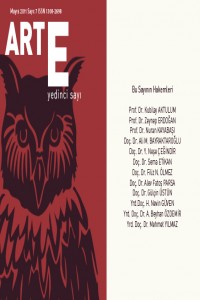Öz
Minyatürler tarihi olayları betimleyen, dönemin yaşam tarzını, örflerini, adetlerini, geleneklerini, göreneklerini aktaran önemli belgelerdir. Minyatürlerde görülen Osmanlı dönemine ait günlük yaşamda ve özel günlerde kullanılmış eşyalar, o döneme ait el sanatları ürünleri hakkında önemli ipuçları vermektedir. Minyatürlerde betimlenen olaylar; padişahın tahta çıkışı, sünnet törenleri, elçi kabulleri, bayramlar, düğünler, şenlikler, dini merasimler olabilmektedir. Minyatürler incelendiğinde, Osmanlı dönemi el sanatlarını uygulayan saray ustalarının teknik, renk, motif, kompozisyon bakımından belirli bir üslup geliştirdiği dikkati çekmektedir. El sanatları ürünlerinde farklı malzemeler kullanılmış olsa bile kompozisyon, renk ve motifler benzer özellikler taşımaktadır. Ahşap, cam, maden, keramik, çini, seramik, porselen, tekstil, taş vb. malzemelerden yapılmış günlük ve özel kullanım eşyaları aynı zamanda minyatürlerde kompozisyonu tamamlayan dekoratif unsurlar olarak yer almaktadır. Örneğin, padişahın arka planında yer verilen perdeler, yerde serili halılar.
Çalışmanın amacı, Osmanlı döneminde yapılmış faklı hammadde özelliği gösteren el sanatlarının minyatürlerdeki izlerini incelemektir. Kaynak tarama yöntemiyle hammaddesi farklı ahşap, cam, tekstil, maden, çini, keramik, keçe, deri işleri ve bunlara uygun olabilecek minyatür örnekleri gözden geçirilmiştir.
Anahtar Kelimeler: Osmanlı, minyatür, el sanatı, süsleme sanatı.
Abstract
Miniatures, depicting historical events, transferring the lifestyle of the era, customs and traditions, are important documents. Objects used in daily life and special occasions seen in the Miniatures in Ottoman-era provide important clues about the handicraft products of that era. Events depicted in miniatures could be accession to the throne of the sultan, circumcision ceremonies, envoy assumptions, holidays, weddings, festivals, religious ceremonies. When miniatures were analyzed, it was noteworthy that the Ottoman period palace crafts masters developed a particular style in terms of technique, color, pattern, composition. Even if different materials were used in handicraft products, the composition, color and motifs were similar. Daily and special use articles that made of wood, glass, metal, ceramic, tile, porcelain, textiles, and stone etc. materials was located at the same time as decorative elements complement the composition of miniatures. For example, the curtains in the background of the sultan, carpets laid to floor. This study included information about raw materials used in handicrafts made in Ottoman period and the period features of handicraft examples, samples used as decorative elements containing miniatures was discussed by examining the Ottoman period miniatures.
Purpose of this paper is to research the traces of the Ottoman period handcrafts -which shows different raw material specialities- on miniatures. Crafts with different raw materials like wood, glass, textiles, tile, ceramic, felt, leather and samples of miniatures which can be appropriate are examined.
Key Words: Ottoman, miniature, handicraft, decorative arts.
Anahtar Kelimeler
Kaynakça
- And, Metin, (2004). Osmanlı Tasvir Sanatları: 1 Minyatür, Türkiye İş Bankası Kültür Yayınları, İstanbul, s-66-210
- Anonymous, (1965). Miniatures Turgues, Unesco-le grand art en édition de poche, Milano, s-23
- Anonim, (1983). Sanat Tarihi Ansiklopedisi, Görsel Yayınlar, Cilt: 4, s- 775-776-783-784
- Anonim, (1990). Turkish Handcrafts, Halk Bankası Yayınları, Creative Yayıncılık, İstanbul, s-129
- Anonim, (1997a). Eczacıbaşı Sanat Ansiklopedisi, “Minyatür” maddesi, Yapı-Endüstri Merkezi Yayınları, Cilt:2, İstanbul, s-1262
- Anonim, (2000). Sûrnâme, Sultan Ahmed’in Düğün Kitabı, Bern, s-18
- Anonim, (2001). İpek- Osmanlı Dokuma Sanatı, TEB İletişim ve Yayıncılık A.Ş. adına Azimuth Editions Limited, İngiltere, s-21-22-24- 25-28-29
- Anonim, (2007a). Anadolu’da İslam Kültür ve Medeniyeti,. Diyanet İşleri Başkanlığı Yayınları: 682, Ankara, s-405
- Anonim, (2007b). Anadolu’da Türk Devri Çini ve Seramik Sanatı, T.C. Kültür ve Turizm Bakanlığı Yayınları, İstanbul, s-302-303-304
- Arlı, Belgin D., Altun, Ara, (2008). Anadolu Toprağının Hazinesi Çini Osmanlı Dönemi, Kale Grubu Kültür Yayınları, Kitap Yayınevi, İstanbul, s-23-25
- Aslanapa, Oktay, (1987). Türk Halı Sanatı’nın Bin Yılı, Eren Yayıncılık ve Kitapçılık Ltd. Şti., İstanbul, s-103-107-137
- Aslanapa, Oktay, (1989). Türk Sanatı, Remzi Kitabevi, İstanbul, s- 354-355
- Aslanapa, Oktay, (2004). Turkish Art and Architecture, Atatürk Kültür Merkezi Başkanlığı Yayınları, Ankara, s-320
- Atasoy, Nurhan, (1997). Sûrnâme-i Hümayun, Düğün Kitabı, Koçbank Yayınları, İstanbul, s-28
- Atıl, Esin, (1999). Levni ve Suname, Bir Osmanlı şenliğinin öyküsü, Koçbank Yayınları, İstanbul, s-154-155
- Bağcı, Serpil, (2003). Konya Mevlana Müzesi, Resimli El Yazmaları, Konya ve Mülhakatı Eski Eserleri Sevenler Derneği Yayınları, Konya, s-150
- Bağcı, Serpil, Çağman, Filiz, Renda, Günsel, Tanındı, Zeren, Osmanlı Resim Sanatı, T.C. Kültür ve Turizm Bakanlığı Yayınları, İstanbul, s- 120-121-182-216
- Barışta, H. Örcün, (1998). Türk El Sanatları, T.C. Kültür Bakanlığı Yayınları, Ankara, s-77-78-86-89-93-95-103-104-105-110-111-112- 161
- Bayramoğlu, Fuat, (1974). Türk Cam Sanatı ve Beykoz İşleri, İş Bankası Kültür Yayınları, İstanbul, s-2-11-12
- Choi, Sunah, (2008). Sûrnâme’i Vehbi’deki Kap Tasvirleri, Ankara Üniversitesi Sosyal Bilimler Enstitüsü, Sanat Tarihi Anabilim Dalı, Yüksek Lisans Tezi, Ankara, s-18-19
- Ergenekon, Cavidan B., (1999). Tepme Keçelerin Tarihi Gelişimi Renk Desen Teknik ve Kullanım Özellikleri, T.C. Kültür Bakanlığı Yayınları, Ankara, s-34-36-37-40
- İrepoğlu, Gül, (1999). Levnî, T.C. Kültür Bakanlığı Yayınları, İstanbul, s-126-127
- Mahir, Banu, (2005). Osmanlı Minyatür Sanatı, Kabalcı Yayınevi, İstanbul, s-65
- Onur, Burcu A., (2007). Osmanlı İmparatorluğu Cam Sanatı ve Çeşm-i Bülbüller, İstanbul Teknik Üniversitesi, Sosyal Bilimler Enstitüsü, Sanat Tarihi Anabilim Dalı, Yüksek Lisans Tezi, İstanbul, s- 19-20
- Özdemir, Melda, Kayabaşı, Nuray, (2007). Geçmişten Günümüze Dericilik, T.C. Kültür ve Turizm Bakanlığı Yayınları, Ankara, s-39-44- 45
- Özgümüş, Üzlifat, (2000). Anadolu Camcılığı, Pera Yayıncılık, İstanbul, s-72
- Pınarbaşı, Simge Ö, (2004). Çağlar Boyu Tahtın Simgesel Anlamları Işığında Türk Tahtları, T.C. Kültür ve Turizm Bakanlığı Yayınları, Sanat Eserleri Dizisi, Özyurt Matbaa, Ankara, s-77-82-83
- Sözen, Metin, Güner, Şemsi, (1998). Geleneksel Türk El Sanatları, Hürriyet Gazetecilik ve Matbaacılık A.Ş., İstanbul, s-34-49-52-60-69- 70-192-156-161
- Uluç, Lale, (2006). Türkmen valiler, Şirazlı ustalar, Osmanlı okurlar, XVI. yüzyıl Şiraz elyazmaları, Türkiye İş Bankası Kültür Yayınları, İstanbul, s-484-485
- Yetkin, Şerare, (1991). Türk Halı Sanatı, Türkiye İş Bankası Kültür Yayınları, Ankara, s-87
- (http://tdkterim.gov.tr/bts/), “Minyatür”. Er.Tar. 09.02.2011
Ayrıntılar
| Birincil Dil | Türkçe |
|---|---|
| Bölüm | Makaleler |
| Yazarlar | |
| Yayımlanma Tarihi | 20 Haziran 2011 |
| Gönderilme Tarihi | 20 Haziran 2011 |
| Yayımlandığı Sayı | Yıl 2011 Cilt: 4 Sayı: 7 |


